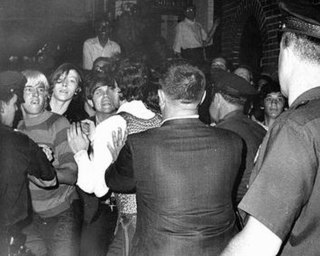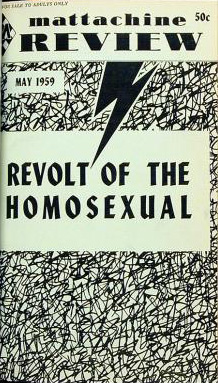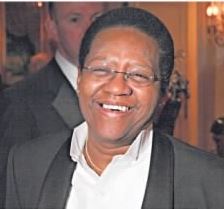Related Research Articles

The Stonewall riots, also known as the Stonewall uprising, Stonewall rebellion, or simply Stonewall, were a series of spontaneous protests by members of the gay community in response to a police raid that began in the early morning hours of June 28, 1969, at the Stonewall Inn in the Greenwich Village neighborhood of Lower Manhattan in New York City. Patrons of the Stonewall, other Village lesbian and gay bars, and neighborhood street people fought back when the police became violent. The riots are widely considered the watershed event that transformed the gay liberation movement and the twentieth-century fight for LGBT rights in the United States.

The Mattachine Society, founded in 1950, was an early national gay rights organization in the United States, preceded by several covert and open organizations, such as Chicago's Society for Human Rights. Communist and labor activist Harry Hay formed the group with a collection of male friends in Los Angeles to protect and improve the rights of gay men. Branches formed in other cities, and by 1961 the Society had splintered into regional groups.
The Lambda Legal Defense and Education Fund, better known as Lambda Legal, is an American civil rights organization that focuses on lesbian, gay, bisexual, and transgender (LGBT) communities as well as people living with HIV/AIDS (PWAs) through impact litigation, societal education, and public policy work.
This is a list of notable events in the history of LGBT rights that took place in the year 1970.

Urvashi Vaid was an Indian-born American LGBT rights activist, lawyer, and writer. An expert in gender and sexuality law, she was a consultant in attaining specific goals of social justice. She held a series of roles at the National LGBTQ Task Force. She is the author of Virtual Equality: The Mainstreaming of Gay and Lesbian Liberation (1995) and Irresistible Revolution: Confronting Race, Class and the Assumptions of LGBT Politics (2012).

One, Inc., or One Incorporated, was one of the first gay rights organizations in the United States, founded in 1952.
This is a list of notable events in the history of LGBT rights that took place in the 1960s.

LGBT pride is the promotion of the self-affirmation, dignity, equality, and increased visibility of lesbian, gay, bisexual, and transgender (LGBT) people as a social group. Pride, as opposed to shame and social stigma, is the predominant outlook that bolsters most LGBT rights movements. Pride has lent its name to LGBT-themed organizations, institutes, foundations, book titles, periodicals, a cable TV channel, and the Pride Library.
LGBT rights organizations are non-governmental civil rights, health, and community organizations that promote the civil and human rights and health of sexual minorities, and to improve the LGBT community. This article focuses on LGBTQIAP+ organizations in the United States of America.

LGBT history in the United States spans the contributions and struggles of lesbian, gay, bisexual, and transgender (LGBT) people, as well as the LGBT social movements they have built.

Chicago has long had a gay neighborhood. Beginning in the 1920s there was active homosexual nightlife in Towertown, adjacent to the Water Tower. Increasing rents forced gay-friendly establishments steadily northwards, moving through Old Town and Lincoln Park along Clark Street and on to Boys Town. Boys Town presently serves as the best-known Chicago gayborhood, and the center of its LGBT culture. Gentrification has pushed many gay and lesbian people to reside ever further north into Uptown, Edgewater and Rogers Park.
Chuck Renslow was an American businessperson, known for pioneering homoerotic photography in the mid-20th-century US, and establishing many landmarks of late-20th-century gay male culture, especially in the Chicago area. His accomplishments included the cofounding with Tony DeBlase of the Leather Archives and Museum, the cofounding with Dom Orejudos of the Gold Coast bar, Man's Country Baths, and the International Mr. Leather competition, and the founding by himself alone of Chicago's August White Party, and the magazines Triumph, Rawhide, and Mars. He was the romantic partner of Dom Orejudos and later Ron Ehemann.
William B. Kelley was a gay activist and lawyer from Chicago, Illinois. Many laud him as an important figure in gaining rights for gay people in the United States, as he was actively involved in gay activism for 50 years.

This is a timeline of notable events in the history of the lesbian, gay, bisexual, and transgender community in the United States.

Vernita Gray was an African-American lesbian and women's liberation activist from the beginning of those movements in Chicago. She began her writing career publishing in the newsletter Lavender Woman. After owning and operating her own restaurant for almost a decade, Gray became the LGBT liaison for the Cook County State's Attorney's office. In 2013, she and her partner became the first same-sex partners to wed in Illinois.
The Chicago Lesbian Liberation (CLL) was a gay liberation organization formed in Chicago for lesbians during the Women's liberation movement (WLM). The group was originally part of an organization for both men and women, but in 1971, the women broke off to form their own group. CLL was involved in publishing a newspaper, Lavender Woman, helping to set up the first Chicago Pride Parade and the first all-women's dance in Chicago.
LGBT culture in St. Louis is strongly influenced by larger regional divisions, such as racial division and the city/county divide. Recorded history and resource flow have tended to prioritize white individuals and the city's central corridor, creating a perception of LGBT culture in St. Louis that does not always align with regional demographics. For the purposes of this article, St. Louis describes the metropolitan area, including neighboring counties in Missouri and Illinois.
The National LGBTQ Wall of Honor is an American memorial wall in Greenwich Village, Lower Manhattan, New York City, dedicated to LGBTQ "pioneers, trailblazers, and heroes". The wall is located inside of the Stonewall Inn and is a part of the Stonewall National Monument, the first U.S. National Monument dedicated to LGBTQ rights and history. The first fifty nominees were announced in June 2019, and the wall was unveiled on June 27, 2019, as a part of the Stonewall 50 – WorldPride NYC 2019 events. Each year five additional names will be added.
Tracy Baim is a Chicago-based LGBT journalist, editor, author, and filmmaker. She is also a former publisher of the Chicago Reader newspaper.
Joanne E. Trapani was an American activist and politician. She was the first open lesbian elected official in Illinois when she won a seat on the village board of Oak Park in 1997, and she was inducted into the Chicago LGBT Hall of Fame in 1993.
References
Citations
- 1 2 "Hanover, Renee C." Chicago Tribune. 7 January 2011. Retrieved 2018-06-03– via Newspapers.com.
- 1 2 3 4 5 Baim, Tracy (5 January 2011). "Renee Hanover dead at 84". Windy City Times. Archived from the original on 2 June 2018. Retrieved 2018-06-02.
- 1 2 3 4 5 6 Kantzavelos, Maria (15 July 2011). "Memorial Will Remember Life of Lesbian Activist and Lawyer" (PDF). Chicago Daily Law Bulletin. 157 (138). Archived from the original (PDF) on 3 June 2018.
- ↑ Sutton, Roger; Ebright, Lisa (1994). Hearing Us Out : Voices From the Gay and Lesbian Community . Boston: Little, Brown. pp. 93. ISBN 0316823260 – via Internet Archive.
- 1 2 Baim 2009, p. 76.
- ↑ Rivas, Jorge (2011-01-20). "Today's Love Goes to Civil Rights Lawyer Renee Hanover | ColorLines". ColorLines. Archived from the original on 26 March 2016. Retrieved 2018-06-03.
- 1 2 3 Kleiman, Carol (6 February 1972). "Legal Help for Harassed Sisters". Chicago Tribune. Retrieved 2018-06-02– via Newspapers.com.
- ↑ Croix, St Sukie de la (2012). Chicago Whispers: A History of LGBT Chicago before Stonewall. Madison, Wisconsin: University of Wisconsin Pres. p. 263. ISBN 9780299286934.
- 1 2 Baim 2009, p. 91.
- ↑ Stewart-Winter, Timothy (2016-02-01). "Beyond Stonewall: How Gay History Looks Different From Chicago". Slate. ISSN 1091-2339. Archived from the original on 17 January 2018. Retrieved 2018-06-04.
- ↑ "Longtime Lesbian Activist Dies". Advocate. 2011-01-06. Archived from the original on 4 June 2018. Retrieved 2018-06-04.
- 1 2 "Renee C. Hanover". Chicago LGBT Hall of Fame. Archived from the original on 2 June 2018. Retrieved 2018-06-02.
Sources
- Baim, Tracy (2009). Out and Proud in Chicago: An Overview of the City's Gay Community. Chicago, Illinois: Agate Publishing. ISBN 978-1-57284-643-2.